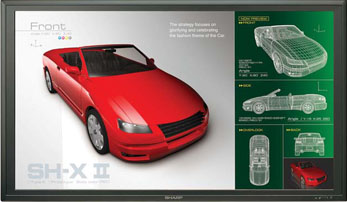- Trends In Dynamic Digital Signage Are Attracting Attention
- It seems that every article on digital signage is mandated to begin with the forecasting of significant market growth, so let’s get this out of the way up front so we can move on to some exciting trends in this evolving niche.
- Both iSuppli and InfoComm in their 2008 market research show that digital signage will grow at double-digit rates even in the harsh economic times we face. The team at iSuppli points to indoor venues as the largest growth segment. There is a lot of truth to the fact that opportunities in corporations, education, security, entertainment, health and medical, and houses of worship will help keep the audiovisual industry alive and well for the next decade. Add to indoor venues some of the opportunities in local and regional retail establishments and you have a dynamic and growing market to cultivate.
- Looking ahead, while it must be said that content is surely king, there are some trends in hardware and software that will assist in market growth and make this creative component of digital signage even more dynamic.
- If the movie The
Sharp PN Series Graduate predicted that the future was in “plastic,” my single word of advice for dynamic digital signage (DDS) is “interactivity.” We humans are an interesting breed. We tend to learn quite quickly and adapt to change. Where once we were content to sit on the sofa and look at the TV, we now TiVo past commercials, except in the case of the ubiquitous home shopping channels which are flourishing. Further proof of the growth of interactivity is the portable video games that abound with kids of all ages punching away at the tiny screens. Of course the biggest example of interactivity is the iPhone and the clones that are flooding the market.
The incorporation of advanced multipoint touchscreen technologies for DDS will expand far beyond the simple onetouch appliances used today. The next phase in touch technology is true interactivity, with the “video concierge” who actually talks to you, makes your hotel, airline, or entertainment reservations, and gives you opinions on the best restaurant in a given locale. We will soon see the “video nurse” in medical facilities to fill out paperwork, set follow- up appointments, discuss your prescriptions, and make you aware of the flu shot you forgot to arrange.
Houses of worship are not immune to interactive technology, no sir. We are seeing the expanding use of portable ATMs for the offering with multiple ways to give, as well as portable wireless displays with Bible verses along with subtexts and the words to the hymns being sent to the handheld displays.
GETTING TO KNOW YOU
Supporting all this content and interactivity is complex software, which is proving most impressive with developments in audience sensing and that dirty word, profiling. You walk by the display in a given location and a database provides information on your ethnicity, sex, height, weight, economic status, viewing habits, and interests. From this they can custom-tailor a message to fit your profile and those of like kind (scary isn’t it?) in order to maximize their specific exposure, and more importantly recollection by their viewers.
Ad Age magazine did a survey some time back in which they stated that in 1965 it took three 30-second commercials to make viewers remember the advertised product. Today it takes 117 exposures to get the same degree of retention. We can see the battle lines being drawn for mind share and audience sensing is the super highway of that effort.
DISPLAYING POTENTIAL
The trends in hardware are less controversial. On the display side we will encounter a renewed battle between LCD and plasma displays for market share. Panel lifetime will exceed 100,000 hours for both technologies and new models will be lighter in weight and much more energy efficient saving as much as 30 percent in power consumption. The plasma gang will continue to push a superior picture quality and better shatter-resistant front glass that will aid in security.
The LCD guys will offer faster panels for better video viewing and new backlights that get them near their plasma brethren in picture quality. We are also seeing some developments in LCD from people like Samsung who now have panels that can stand up to 24/7/365 use and avoid the “bogeyman” of LCD image retention.
Plasma manufacturers like Panasonic are answering their burn-in issues with advanced anti-burn systems making, them better suited to the severe use of digital signage.
On the new flat panel technology side, we continue to stay tuned for developments in OLED. Please note, the LCD and plasma groups are not going away and reasonably priced OLED is a ways off. How far of you ask? Our best guesstimate is four to five years.

LG Electronics Stretch Screen digital-signage-in-a-box concept. Samsung offers a full built-in PC, and its proprietary MagicInfo software program is included in the cost of the display with no additional monthly fees. Both NEC and Sony have bundled products and programs to address the same market niche. These are aimed directly at those wanting a do-it-yourself approach.
Stay tuned as we march forth into the unchartered world we call dynamic digital signage.










